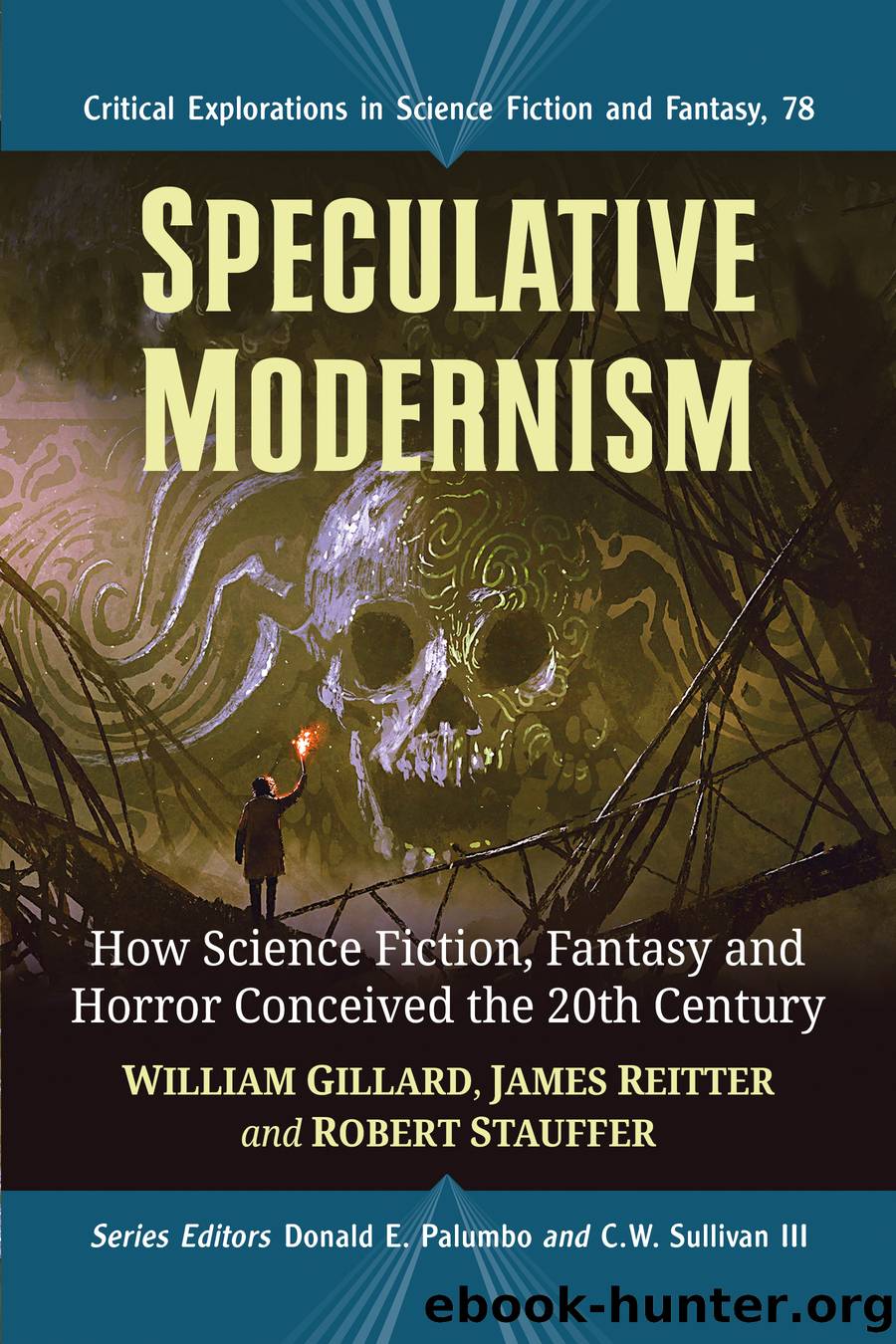Speculative Modernism by William Gillard

Author:William Gillard
Language: eng
Format: epub
Publisher: McFarland & Company, Inc., Publishers
Published: 2021-11-08T00:00:00+00:00
âWeâre Down; Weâre Beatâ: Humanityâs Defeat
H.G. Wellsâs fear of the rampaging monsters that could exterminate us like we were common roaches is the nightmare that lasted the whole Speculative Modernist eraâin both his book, The War of the Worlds, and its adaptation in the Orson Wellesâs Mercury Theatre production on Halloween Eve in 1938. In The War of the Worlds, our narrator encounters several different types of people as he flees the Martians. One of the last is an artilleryman, from whom we get the sectionâs title (214). He has decided that mankind cannot win the war with the Martians, and so the humans must surrender for now in order to live to another day. The presumption of the novel is that those who can cross through the void of space must be technologically advanced and therefore a threat to us, as we would be to them. This terror stands the test of time, and maybe acts as a warning for those who would conquer others to think just a little bit about the conquered. His book was not the first, however, nor would it be the only one where biology would win the day. This section looks at some of those works that explore other existential threats to humanity. The warning should not only be for the monsters who would come with ray guns firing. There are plenty of other kinds of threats too. As the universe grows in the dimensions of time and space, so too do the number of threats humankind might face, and not all of them would simply be better fighters.
Edward ÂBulwer-Lyttonâs novel The Coming Race (1871) stands as a link between the travel stories like the medieval works The Voyage of St. Brendan (about 900) and The Travels of Sir John Mandeville (approximately 1357) as well as the parody adventures of Jonathan Swiftâs Gulliverâs Travels and many others throughout the eras of exploration, with H.G. Wells and the Speculative Modernists. ÂBulwer-Lytton uses a Âfirst-person narrative to tell the story of an unnamed young American who is invited to help with an inspection of a very deep mine. When he tumbles down an extraordinarily deep shaft, he finds himself among a strange race of beings that live entirely underground called the ÂVril-ya. These beings are spiritually, technologically, politically, and in almost every other way superior to his fellow superterraneans. Within minutes of his discovery, the narrator is fed, housed, and educated through their superior mind control in the ways of their language and culture. Like many of the utopian novels both before and after The Coming Race, the narrator describes this perfect culture and compares it to his own through discussions with one or two of the beings set to be his guides.
The book is important to the Speculative Modernists for two great developments. The first is that this race is not only more just and efficient, but technologically superior as well. In fact, technology is what makes them who they are. The ÂVril-ya have discovered the secret of vril, the essence of all power.
Download
This site does not store any files on its server. We only index and link to content provided by other sites. Please contact the content providers to delete copyright contents if any and email us, we'll remove relevant links or contents immediately.
Half Moon Bay by Jonathan Kellerman & Jesse Kellerman(732)
The Power of Myth by Joseph Campbell & Bill Moyers(724)
A Social History of the Media by Peter Burke & Peter Burke(669)
Inseparable by Emma Donoghue(643)
The Complete Correspondence 1928-1940 by Theodor W. Adorno & Walter Benjamin(545)
The Spike by Mark Humphries;(513)
A Theory of Narrative Drawing by Simon Grennan(506)
Bodies from the Library 3 by Tony Medawar(503)
Ideology by Eagleton Terry;(492)
Culture by Terry Eagleton(490)
World Philology by(476)
Farnsworth's Classical English Rhetoric by Ward Farnsworth(463)
A Reader’s Companion to J. D. Salinger’s The Catcher in the Rye by Peter Beidler(451)
Adam Smith by Jonathan Conlin(447)
Comic Genius: Portraits of Funny People by(431)
High Albania by M. Edith Durham(426)
Game of Thrones and Philosophy by William Irwin(423)
Monkey King by Wu Cheng'en(420)
Early Departures by Justin A. Reynolds(401)
